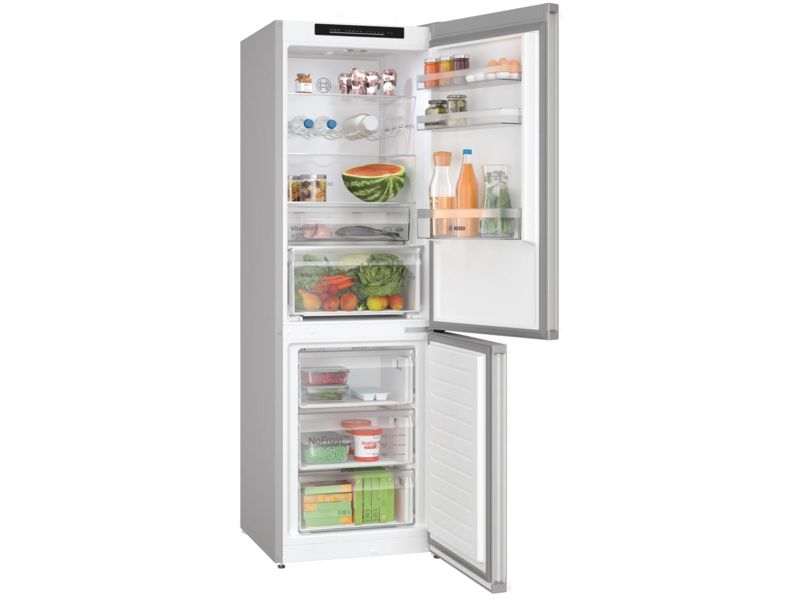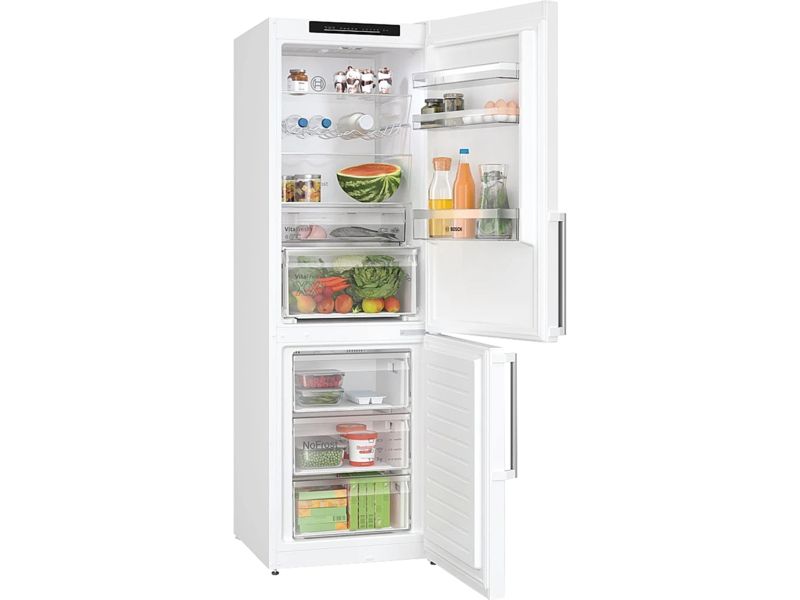Common fridge freezer faults and how to deal with them

In this article
- Fridge is too warm
- Freezer isn’t freezing properly
- Water pooling in the base of the fridge
- Fridge freezer stopped working after defrosting
- Fridge freezer is noisier than usual
- Light in the fridge not working
- Door seals torn or not working properly
- Is it worth repairing an old fridge freezer?
When your fridge freezer is playing up, you want it working again fast. But getting a fridge freezer repaired can be disruptive and expensive. Before you reach for the phone, could it be something you could fix yourself?
Read on to find out how you can go about diagnosing some common faults, how to do simple fixes and when it's worth calling in a professional.
Looking for a new model? Our fridge freezer reviews can help.
Fridge is too warm

Assuming that you've set it up properly (it's level, not too close to heat sources and has enough ventilation space all around) and the ambient room temperature is within the range of the appliance's climate class, run through these checks to see if they help solve the problem.
- Has the thermostat dial been adjusted? Some dials can shift with the slightest of nudges, so check it hasn't been accidentally moved to a warmer setting.
- Can the door close properly? Check for obstructions and damage around the hinges and seal that could be letting in warm air.
- Is the fridge overfilled? Jam-packed shelves prevent cool air from circulating around the interior of the fridge, which could leave your food too warm.
- The thermostat is broken The problem could also lie with the thermostat behind the temperature dial in your fridge. Replacing a thermostat is straightforward enough – replacement parts cost from around £30 and you'll only need a few home DIY tools. But it's probably not a job for a complete novice, as determining it's actually a broken thermostat causing the problem takes a bit of know-how. If your fridge-freezer has digital controls on the front, this is much more difficult to fix and worth calling a professional to get a quote.
Find out more about freezer climate classes in our guide to the best freezers and chest freezers for garages.
Freezer isn’t freezing properly

In addition to the checks listed above, there are a couple more you can make to try and diagnose the cause of a freezer not freezing, before you call in an engineer.
- Find the fan inside the freezer and make sure that nothing is impeding it. If it's blocked up, move things around and give it space to work. Also check to see if a build-up of ice is preventing it from moving freely.
- Take a look at the condenser coils at the back of the appliance, too. A build-up of dust on these can prevent them from cooling properly. A good clean will have them working efficiently, which may solve the lack of freezing.
If those simple checks don't solve the problem, you'll have some more complex investigations on your hands. Issues with the compressor, thermostat or refrigerant gas are just some of the areas that could be to blame. Unless you have the tools and the know-how, it's probably time to call an engineer.
Our guide to the most reliable fridge freezer brands will help you choose the right one for you.
Water pooling in the base of the fridge

This is likely to be caused by a blocked drain hole. Water condenses at the back of the fridge, where it's colder, and runs down into the drain hole, where it can be evaporated away by the compressor.
Dust, dirt and food waste often get stuck in the drain hole, preventing water from running down, but you can easily clean it with a thin straw, bit of wire or a cotton bud.
Another option if it's still blocked is to irrigate the pipe with a syringe that has a tube attachment. A few flushes of water will hopefully shift whatever's causing the blockage.
Our guide on how to clean a fridge has plenty more tips on keeping yours free of grime.
Fridge freezer stopped working after defrosting

If your freezer has chunks of ice on the back and side walls, it can be tempting to use a utensil to lever off the ice. However, this can crack a pipe or the rear of the inner casing, causing the refrigerant gas to leak out.
Gas leaks are dangerous and tricky to fix, and re-gassing can cost more than £100, so a replacement is often more cost-effective.
To avoid any mishaps, follow the tips in our guide on how to defrost a fridge freezer.
Fridge freezer is noisier than usual

You'll probably hear plenty of noises coming from your fridge freezer throughout the day, from the hum of the compressor and whirr of the evaporator fan to the occasional crack of defrosting ice. But if you're suddenly hearing unusual noises, you'll want to investigate to see whether it could be a bigger problem.
An unusually noisy fridge could be caused by the compressor or the evaporator tray on top of it. A compressor pushes the refrigerant gas into the coils on the outside. It can fail (the noise can be a warning sign) or the evaporator tray can move so it starts making a noise.
If it's an issue with the evaporator tray, it's easily fixed. But if the compressor breaks it can cost more than £170 to buy a new one, and you'll have to factor in the additional cost of getting an engineer in to fit it. So unless it's an expensive American-style fridge freezer, you'll probably want to weigh up whether or not it's worth fixing.
Find out how to dispose of or recycle an old fridge freezer.
Light in the fridge not working

This should be a simple fix if the light has a small screw-in bulb, so it's unlikely that you'll need to get an engineer to sort this one for you. But there are some fridge freezers that have LED strip lighting inside, and in some cases it might be better to hand the job over to a professional, unless you know what you're doing.
If you think you can fix it yourself, then first make sure you have the correct replacement bulb or light module. You can search for spare parts online using your appliance's model code.
Some manufacturers, such as Beko and Hotpoint, have their own spare parts websites, but it can be worth shopping around to see if you can find parts cheaper elsewhere.
Remember to make sure the appliance is switched off at the wall and unplugged before you begin working.
See our tips on how to keep food fresher for longer.
Door seals torn or not working properly

If your food is spoiling sooner than it should, it could be an issue with the door seal. Check for any tears, warping in the corners or even areas where the seal has hardened.
If there's no obvious damage or wear, you can try the £10 note test to see how well the seal is working. Close the door onto the note, and if it holds in place the seal is working properly. If the note slides out, you'll need to replace the seal. Remember to test all the way around the door, not just next to the handle.
You can replace the seal yourself. Sometimes it's as easy as pulling the old one out, but you might have to loosen some screws that keep it in place.
New seals are often available online, for between £30 and £100.
Is your cold appliance correctly set? See what temperature should a fridge be? and what temperature should a freezer be?
Is it worth repairing an old fridge freezer?

This will depend on how old yours is and what's wrong with it. When we surveyed owners about faults, the most common issues reported were cracked or broken drawers, blocked drains and outlets, and a build-up of ice in the fridge or freezer compartment.
These type of issues can sometimes be rectified without needing to call in the experts. If you're in any doubt, check your appliance's instruction manual or the manufacturer's website for a troubleshooting guide.
Right to Repair laws around large appliances such as fridge freezers mean that manufacturers now have to make spare parts available. The new rules also state that repairs need to be possible using everyday tools, however some repairs may only be carried out by a professional repairer.
Spare parts including items such as door handles, door hinges, trays and baskets should be available to everyone for a minimum period of 10 years, so if you're handy with a screwdriver, you might be able to make very basic repairs yourself. For professional repairers, light sources, printed circuit boards (PCBs), temperature sensors and thermostats need to remain available for a minimum period of seven years.
For more catastrophic faults, such as a broken compressor, which isn't as easily or as cheaply fixed, you may need to speak to the experts, check your warranty or make a call on whether it's actually worth repairing or not. If it's really broken, you may be better off investing in a newer, more energy-efficient model.
Not worth repairing? Read our guide to the best fridge freezers before you hunt for a replacement.


